-
Countries
-
Data and Analysis
-
Special Focus
-
Crisis Responses
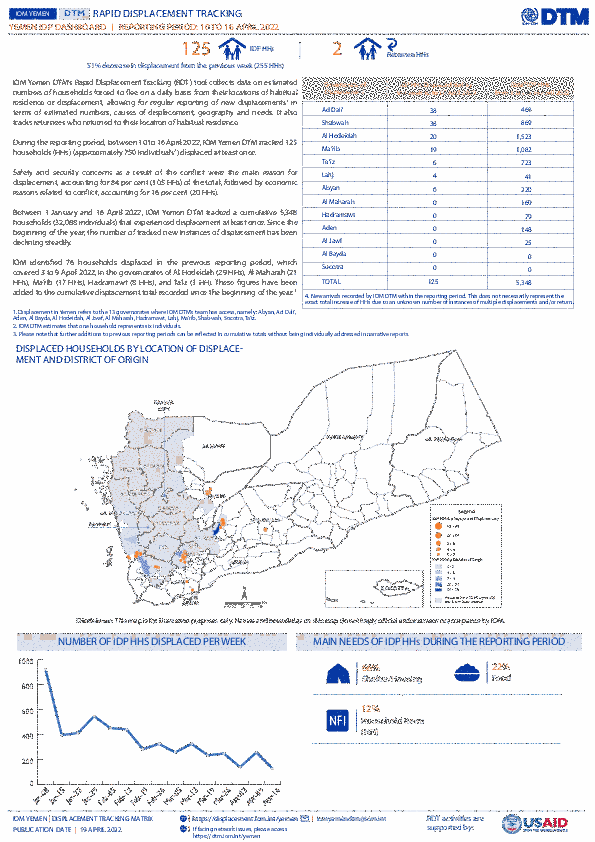
Contact
DTM Yemen, iomyemendtm@iom.int
Language
English
Location
Yemen
Period Covered
Apr 10 2022
Apr 16 2022
Activity
- Mobility Tracking
IOM Yemen DTM’s Rapid Displacement Tracking (RDT) tool collects data on estimated numbers of households forced to flee on a daily basis from their locations of origin or displacement, allowing for regular reporting of new displacements in terms of estimated numbers, geography, and needs. It also tracks returnees who returned to their location of origin.
From 1 January to 16 April 2022, IOM Yemen DTM tracked 5,348 households (HH) (32,088 Individuals) who experienced displacement at least once.
Between 10 and 16 April 2022, IOM Yemen DTM tracked 125 households (750 individuals) displaced at least once. The majority of people moved into/within the following governorates and districts:
- Ad Dali (38 HHs) – Qatabah (26 HHs), Ad Dali (12 HHs) districts. Most displacements in the governorate originated from Ad Dali and Ibb.
- Shabwah (38 HHs) – Bayhan (32 HHs), Ataq (6 HHs) districts. Most displacements in the governorate originated from Al Bayda.
- Al Hodeidah (20 HHs) – Hays (18 HHs), Al Khukhah (2 HHs) districts. Most displacements in the governorate originated from Al Hodeidah and Taiz.
The majority of people moved from the following governorates and districts:
- Al Bayda (35 HHs) – Nati (28 HHs), Numan (4 HHs), Az Zahir - Al Bayda (2 HHs) districts.
- Al Hodeidah (30 HHs) – Hays (11 HHs), Zabid (6 HHs), At Tuhayta (4 HHs) districts.
- Ad Dali (19 HHs) – Qatabah (12 HHs), Al Husha (3 HHs), Damt (3 HHs) districts.
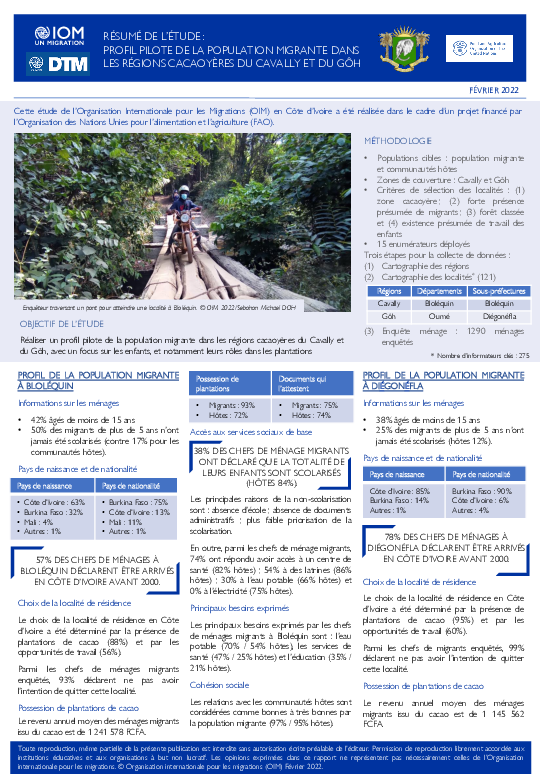
Contact
ANanquette@iom.int
Language
French
Location
Côte d’Ivoire
Period Covered
Feb 01 2022
Feb 28 2022
Activity
- Flow Monitoring
Cette étude de l’Organisation Internationale pour les Migrations (OIM) en Côte d’Ivoire a été réalisée dans le cadre d’un projet financé par l’Organisation des Nations Unies pour l’alimentation et l’agriculture (FAO), afin de réaliser un profil pilote de la population migrante dans les régions cacaoyères du Cavally et du Gôh, avec un focus sur les enfants, et notamment leurs rôles dans les plantations.
Contact
DTM Yemen, iomyemendtm@iom.int
Location
Yemen
Activity
- Event Tracking
- Mobility Tracking
Period Covered
Apr 10 2022 -Apr 16 2022
IOM Yemen DTM’s Rapid Displacement Tracking (RDT) tool collects data on estimated numbers of households forced to flee on a daily basis from their locations of origin or displacement, allowing for regular reporting of new displacements in terms of estimated numbers, geography, and needs. It also tracks returnees who returned to their location of origin.
From 1 January to 16 April 2022, IOM Yemen DTM tracked 5,348 households (HH) (32,088 Individuals) who experienced displacement at least once.
Between 10 and 16 April 2022, IOM Yemen DTM tracked 125 households (750 individuals) displaced at least once. The majority of people moved into/within the following governorates and districts:
From 1 January to 16 April 2022, IOM Yemen DTM tracked 5,348 households (HH) (32,088 Individuals) who experienced displacement at least once.
Between 10 and 16 April 2022, IOM Yemen DTM tracked 125 households (750 individuals) displaced at least once. The majority of people moved into/within the following governorates and districts:
- Ad Dali (38 HHs) – Qatabah (26 HHs), Ad Dali (12 HHs) districts. Most displacements in the governorate originated from Ad Dali and Ibb.
- Shabwah (38 HHs) – Bayhan (32 HHs), Ataq (6 HHs) districts. Most displacements in the governorate originated from Al Bayda.
- Al Hodeidah (20 HHs) – Hays (18 HHs), Al Khukhah (2 HHs) districts. Most displacements in the governorate originated from Al Hodeidah and Taiz.
- Al Bayda (35 HHs) – Nati (28 HHs), Numan (4 HHs), Az Zahir - Al Bayda (2 HHs) districts.
- Al Hodeidah (30 HHs) – Hays (11 HHs), Zabid (6 HHs), At Tuhayta (4 HHs) districts.
- Ad Dali (19 HHs) – Qatabah (12 HHs), Al Husha (3 HHs), Damt (3 HHs) districts.
The majority of people moved from the following governorates and districts:
Population Groups
Survey Methodology
Unit of Analysis Or Observation
Type of Survey or Assessment
Keywords
Geographical Scope
Administrative boundaries with available data
The current dataset covers the following administrative boundaries

Contact
ANanquette@iom.int
Language
French
Location
Côte d’Ivoire
Period Covered
Feb 01 2022
Feb 28 2022
Activity
- Other
Ce rapport pilote a été fruit d’un partenariat entre l’Organisation Internationale pour les Migrations (OIM) et l’Organisation des Nations-Unies pour l’alimentation et l’agriculture (FAO), entend contribuer à répondre à la priorité du Gouvernement de Côte d’Ivoire d’éliminer le travail des enfants et à assurer la durabilité de la filière du cacao et le développement de politiques informées de lutte contre la déforestation. Cet exercice de collecte et d’analyse des données est réalisé en coordination avec le Comité National de Surveillance des Actions de Lutte contre la Traite, l’Exploitation et le Travail des Enfants (CNS), le Comité Interministériel de Lutte contre la Traite, l’Exploitation et le Travail des Enfants (CIM), via particulièrement la Direction de la lutte contre le travail des enfants (DLTE), ainsi que l’Institut National de la Statistique (INS) avec qui la méthodologie et les différentes étapes du projet ont été validées.
Cet partenariat entre l’OIM et la FAO combine les expertises respectives en matière de suivi et de protection des populations mobiles d’un côté, et en matière de travail et développement du secteur agricole en Côte d’Ivoire de l’autre, mettant ainsi à profit la complémentarité des mandats et des actions des deux agences des Nations Unies.
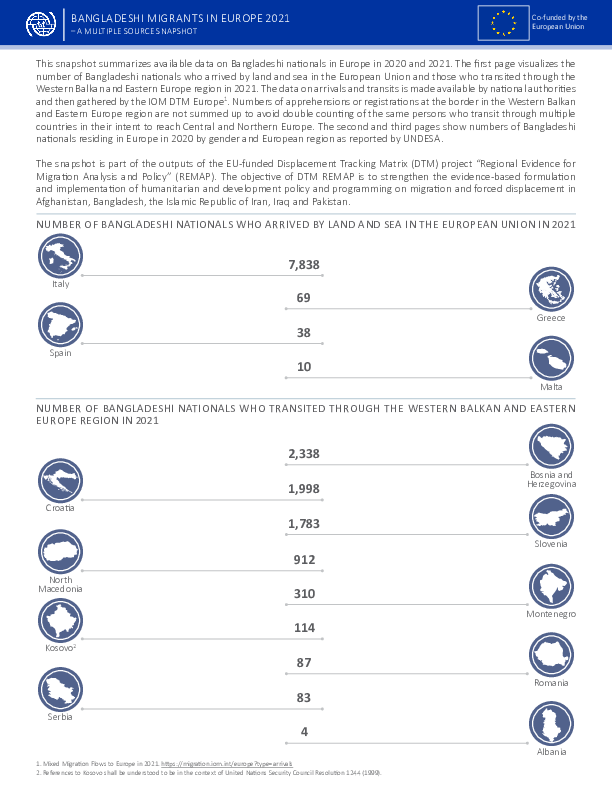
Contact
REMAPBD@iom.int
Language
English
Location
Bangladesh
Period Covered
Jan 01 2021
Dec 31 2021
Activity
- Flow Monitoring
This snapshot summarizes available data on Bangladeshi nationals in Europe in 2020 and 2021. The first page visualizes the number of Bangladeshi nationals who arrived by land and sea in the European Union and those who transited through the Western Balkan and Eastern Europe region in 2021. The data on arrivals and transits is made available by national authorities and then gathered by the IOM DTM Europe1. Numbers of apprehensions or registrations at the border in the Western Balkan and Eastern Europe region are not summed up to avoid double counting of the same persons who transit through multiple countries in their intent to reach Central and Northern Europe. The second and third pages show numbers of Bangladeshi nationals residing in Europe in 2020 by gender and European region as reported by UNDESA. The snapshot is part of the outputs of the EU-funded Displacement Tracking Matrix (DTM) project “Regional Evidence for Migration Analysis and Policy” (REMAP). The objective of DTM REMAP is to strengthen the evidence-based formulation and implementation of humanitarian and development policy and programming on migration and forced displacement in Afghanistan, Bangladesh, the Islamic Republic of Iran, Iraq and Pakistan.

Contact
iomisbdtmremapteam@iom.int
Language
English
Location
Pakistan
Period Covered
Mar 26 2022
Apr 08 2022
Activity
- Flow Monitoring
IOM Pakistan collects data on the outflows of undocumented Afghan migrants at the Torkham and Chaman border crossing points in an effort to better understand the migration movements of undocumented Afghan migrants returning to Afghanistan from Pakistan. This exercise is part of the European Union funded project “Displacement Tracking Matrix Regional Evidence for Migration Analysis and Policy (DTM REMAP)”. From 26 March to 08 April 2022, 3,553 undocumented Afghan migrants returned to Afghanistan, including 460 through the Torkham border point and 3,093 through the Chaman border point. During the reporting period, border authorities facilitated the return of 35 individuals due to the lack of legal documentation to remain in Pakistan. Therefore, information concerning these 35 individuals is not included in the report analysis.
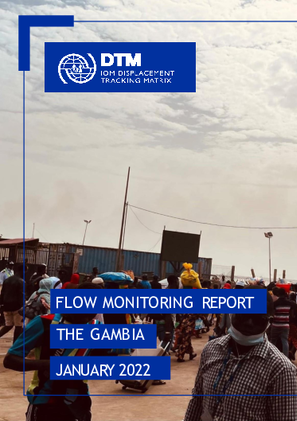
Contact
Kumbale GOODE, KuGoode@iom.int
Language
English
Location
The Gambia
Period Covered
Jan 01 2022
Jan 31 2022
Activity
- Flow Monitoring Survey
- Flow Monitoring
The Flow Monitoring tool collects data on migration flows and trends, traveller profiles, migration journeys and intentions of migrants in order to obtain a deeper view of mobility in West and Central Africa. In The Gambia, DTM conducts Flow Monitoring activities at several important transit locations in: 1) Barra (FMPs are located at the ferry terminal and the main garage); 2) Farafenni (FMPs are located at Farafenni main garage, Farafenni Ballan-Ghar garage, Farafenni McCarthy and Sanjally garage, Farafenni turntable garage and the truck garage); 3) Basse (FMPs are situated at the main garage and the bus station in Basse Santa-Su) and 4) Brikama (FMPs are located at the main garage and the Bus station).
These activities enable DTM to monitor the movements of passengers within, out of and towards The Gambia as well as the movements of those passengers transiting The Gambia.
This report presents the key results from the Flow Monitoring Survey conducted from the 1 to 31 January 2022.
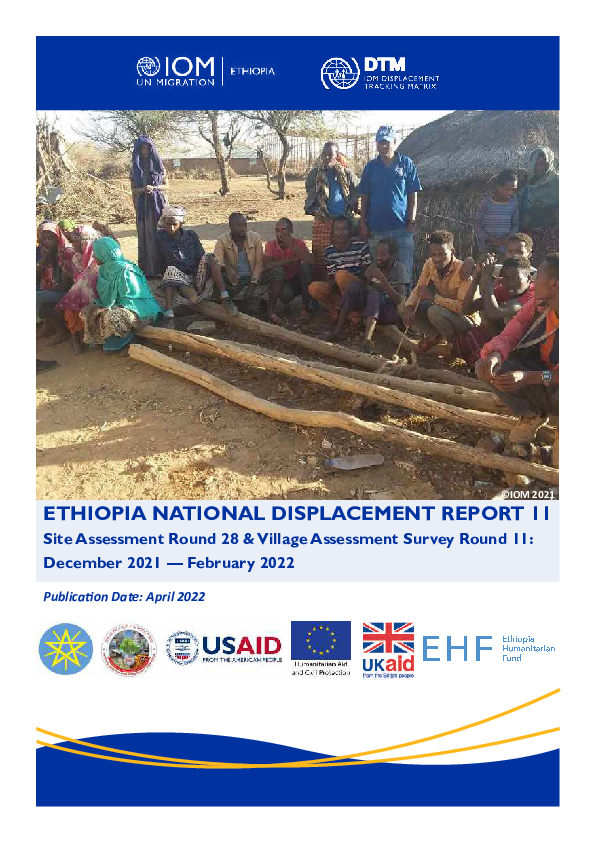
Contact
DTM Ethiopia, SLOAddisAbabaDTM@iom.int
Language
English
Location
Ethiopia
Period Covered
Dec 01 2021
Feb 15 2022
Activity
- Site Assessment
- Mobility Tracking
- Village Assessment
In order to capture the displacement and return dynamics in Ethiopia, DTM Ethiopia's National Displacement Report combines findings from its Site Assessment (SA) in Section 1 and findings from the Village Assessment Survey (VAS) in Section 2. The Site Assessment tracks the number of internally displaced persons (IDPs), while the Village Assessment Survey tracks the number of IDPs who are returning or have returned to their communities.
As of February 2022, a total of 4.51 million IDPs have been identified thus far across the country. Of the total displaced population, the main causes of displacement were conflict which displaced 3.63 million IDPs (81%), drought which displaced 420,887 IDPs (9%), social tension which displaced 171,727 IDPs (4%), seasonal floods which displaced 122,901 IDPs (3%) and flash floods which displaced 119,807 IDPs (3%).
Through Site Assessment round 28 (Dec 2021-Jan 2022), 2.06 million IDPs were identified in 1,440 IDP sites across 9 regions in Ethiopia. Notably, there was a +37% increase in the number of drought IDPs this round due to the intensifying drought, especially in Afder, Dawa, Dollo and Liban zones in Somali region and West Guji zone in Oromia region. Through Emergency Site Assessment round 9 (Jan-Feb 2022), 175,264 IDPs were identified across 83 IDP sites in Afar region and 462,529 IDPs were identified across 560 IDP sites in Amhara region respectively. However, Zone 2 in Afar region was largely inaccessible due to active conflict and insecurity, and thus affected the total number of IDPs that could be identified. The IDP figures in both regions have decreased significantly following the withdrawal of armed conflict in eastern Amhara (mainly North Wello, South Wello and North Shewa zones) and parts of western Afar (Zone 4 and Zone 1). Through Emergency Site Assessment round 8 (Aug 2021), 1.8 million IDPs were identified in 581 IDP sites in Tigray region. However, please note that this information requires updating as a new round could not be conducted for the past 6 months due to a lack of fuel and cash. It is anticipated that the number of IDPs in Tigray should have dropped very significantly due to returns since August 2021.
Through Village Assessment Survey round 11 (Dec 2021-Feb 2022), a total of 2.85 million returning IDPs were identified in 2,378 villages across 11 regions (except Tigray region due to a lack of fuel and cash). 2.7 million returning IDPs (94%) were initially displaced due to conflict, 54,129 returning IDPs (2%) were initially displaced due to seasonal floods and 51,540 returning IDPs due to drought (2%). Significantly, this round’s returning IDP number has increased substantially due to the mass return of 1.5 million returning IDPs, mainly concentrated in the east of Amhara region (North Shewa, North Wello and South Wello zones), following the withdrawal of armed conflict.
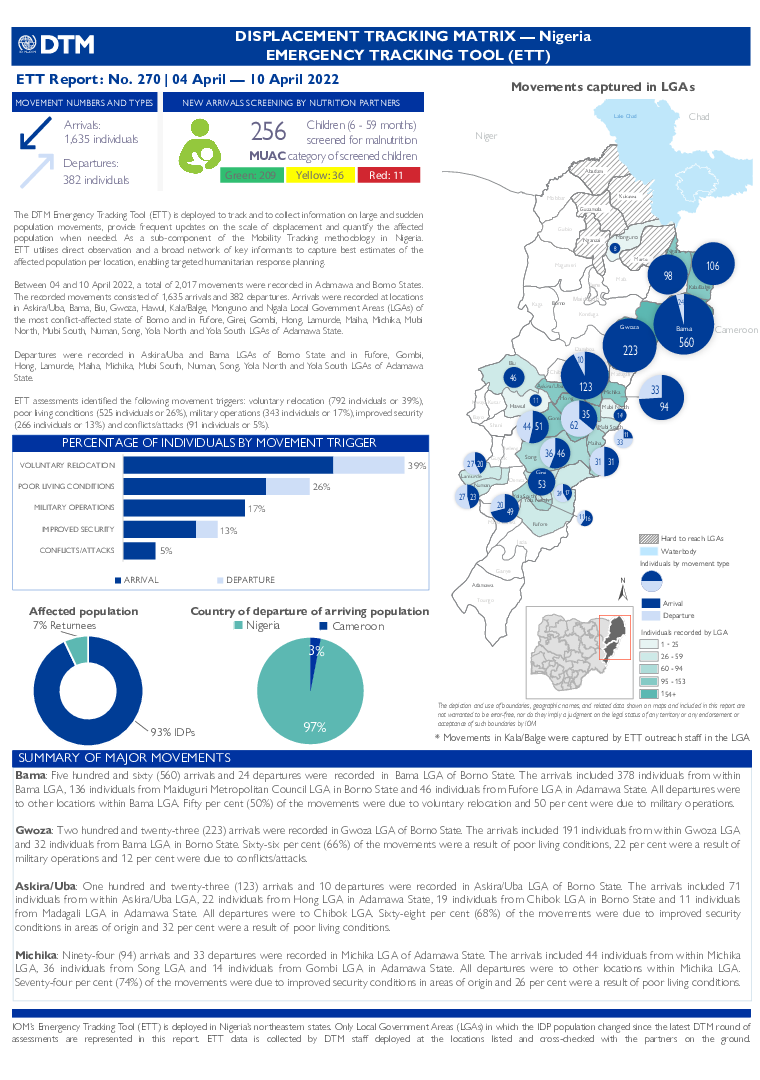
Contact
DTM Nigeria, AllUsersInDTMNigeria@iom.int
Language
English
Location
Nigeria
Period Covered
Apr 04 2022
Apr 10 2022
Activity
- Event Tracking
- Mobility Tracking
The DTM Emergency Tracking Tool (ETT) is deployed to track and to collect information on large and sudden population movements, provide frequent updates on the scale of displacement and quantify the affected population when needed. As a sub-component of the Mobility Tracking methodology in Nigeria.
ETT utilises direct observation and a broad network of key informants to capture best estimates of the affected population per location, enabling targeted humanitarian response planning.
Between 04 and 10 April 2022, a total of 2,017 movements were recorded in Adamawa and Borno States. The recorded movements consisted of 1,635 arrivals and 382 departures. Arrivals were recorded at locations in Askira/Uba, Bama, Biu, Gwoza, Hawul, Kala/Balge, Monguno and Ngala Local Government Areas (LGAs) of the most conflict-affected state of Borno and in Fufore, Girei, Gombi, Hong, Lamurde, Maiha, Michika, Mubi North, Mubi South, Numan, Song, Yola North and Yola South LGAs of Adamawa State.
Departures were recorded in Askira/Uba and Bama LGAs of Borno State and in Fufore, Gombi, Hong, Lamurde, Maiha, Michika, Mubi South, Numan, Song, Yola North and Yola South LGAs of Adamawa State.
ETT assessments identified the following movement triggers: voluntary relocation (792 individuals or 39%), poor living conditions (525 individuals or 26%), military operations (343 individuals or 17%), improved security (266 individuals or 13%) and conflicts/attacks (91 individuals or 5%).

Contact
DTM Niger, DTMNiger@iom.int
Language
French
Location
Niger
Period Covered
Feb 01 2022
Feb 28 2022
Activity
- Flow Monitoring Survey
- Flow Monitoring
Le suivi des flux de populations récolte des données sur les flux et tendances migratoires, les profils des voyageurs et les parcours et intentions des migrants, afin de fournir une meilleure compréhension des mobilités en Afrique de l’Ouest et du Centre.
Au Niger, la DTM recueille des données à 7 Points de suivi des flux (Flow Monitoring Point, FMP), dans le but d’identifier les zones à forte mobilité transfrontalière et intra régionale et récolter des données sur les tendances de mobilités et les profils et parcours des voyageurs dans le pays.
Ce rapport présente les données obtenues au travers des activités d’enregistrement des flux en février 2022.